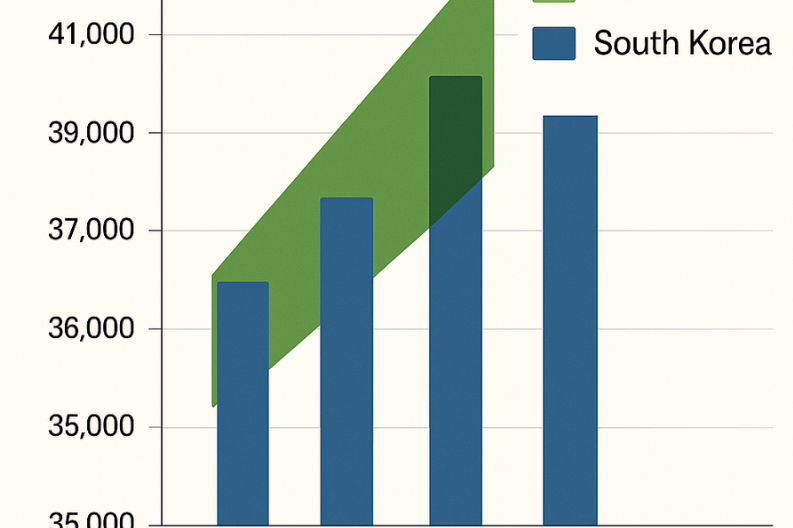The Taiwan set to surpass South Korea in GDP by 2025 report from the International Monetary Fund (IMF) shows a major shift in East Asia’s economy. On October 22, the IMF released data revealing that South Korea’s per capita GDP will slightly decline this year, while Taiwan’s economy continues to rise. This change marks a new turning point for the region’s financial balance.
Per capita GDP measures the average income or economic output per person. It helps show how rich a country is. The IMF estimates South Korea’s per capita GDP at USD 35,962 in 2025, down 0.8% from last year’s USD 36,239. Due to this dip, South Korea’s global ranking could fall from 34th to 37th among 197 countries.
Even so, the IMF expects South Korea’s economy to recover later. By 2028, it could cross the USD 40,000 mark and reach USD 40,802. However, its global position may continue to drop, from 37th this year to 41st by 2029.
In contrast, Taiwan’s economy shows strong momentum. The IMF forecasts an 11.1% rise in Taiwan’s per capita GDP this year, from USD 34,060 to USD 37,827. This growth will lift Taiwan’s global rank from 38th to 35th. By 2025, Taiwan is expected to reach USD 41,586, crossing the USD 40,000 milestone two years ahead of South Korea. That progress could place it 31st worldwide.
This data highlights a major economic shift in East Asia. Taiwan’s steady growth shows a bright outlook for its economy. The IMF predicts that by 2030, Taiwan’s per capita GDP will exceed USD 50,000, while South Korea’s will reach USD 44,262. This means Taiwan may continue to grow faster than its regional rival.
The Korea Center for International Finance (KCIF) reports that leading global banks project Taiwan’s real GDP growth at 5.3% as of September. Research firm Nomura recently raised its forecast for Taiwan’s third-quarter GDP from 3% to a remarkable 7.6% year-on-year, showing stronger economic performance than expected.
Taiwan still faces challenges such as weak domestic demand and low investment. Yet, its powerful semiconductor industry continues to fuel growth. This sector drives global technology production and remains Taiwan’s strongest pillar of economic success.
Meanwhile, Japan is also showing steady progress. The IMF projects Japan’s per capita GDP will grow by nearly 7%, rising from USD 32,443 last year to USD 34,713 this year. Even with this improvement, Japan’s global rank is expected to remain at 40th. It could cross USD 40,000 by 2029, one year after South Korea.
Globally, the richest economies continue to lead the charts. The IMF ranks Liechtenstein first with a per capita GDP of USD 231,071, followed by Luxembourg (USD 146,818), Ireland (USD 129,132), and Switzerland (USD 111,047). Other high-ranking nations include:
- Iceland: USD 98,150
- Singapore: USD 94,481
- Norway: USD 91,884
- United States: USD 89,599
- Denmark: USD 76,481
- Macau: USD 74,921
These numbers reflect how global economies evolve over time. South Korea remains an economic powerhouse, but Taiwan’s rapid growth stands out. Its combination of innovation, exports, and advanced industries continues to push it forward.
In conclusion, the Taiwan set to surpass South Korea in GDP by 2025 marks a new phase in East Asia’s economic story. While South Korea faces short-term challenges, Taiwan’s rise represents strength, technological leadership, and a promising future for the region’s growth.



